










April 23, 2006 - Post No. 62

Undoubtedly one of the most memorable moments of my own life as a follower of Jesus came this morning when, at the summit of a wondrous Easter Badarak, from the tomb where the lifeless body of Jesus once lay, came the Eucharistic meal, the Body and Blood of the Risen Lord, King of Kings, Lord of Lords, Source of abundant Life, and Prince of ultimate Peace.
A most memorable Easter morning for me, indeed, and undoubtedly the longest one as well! The day begins at 2 a.m. when the monks and pilgrims gather at the front gate answering the call of cathedral bell. (Click here to listen to the ringing of the bell.) In the quiet of the early morning, we walk down to the Church of the Resurrection for three liturgies that will take place over the next seven hours. As we walk along, one of the younger monks whispers to me, "You know, this is the exact hour of the Resurrection." To my responding query as to why the ceremony of Holy Fire takes place midday on Saturday, he simply shrugs his shoulders and says, "Who knows?"
When we enter the Church of the Resurrection, we climb the steep steps to the Calvary Chapel, and each take a turn reverencing the rock of Golgotha where the Saviour gave up his life. From there we move on to the Armenian Gallery in the great rotunda of the Resurrection Basilica where Daron Serpazan, Archbishop of France -- pictured here (below, left) with Fr. Kegham in a photo taken later in the day -- presides at the office of Easter Nocturnes.

The Greek Orthodox Easter Liturgy is taking place before the doorway to the Aedicule and its Empty Tomb, below us, down on the floor of the rotunda. There are at least 20 Greek concelebrants, all robed in the bright crimson vestments of the Divine Liturgy. The chants of the Greek liturgy blend easily with the singing of the nocturnal Office of the Resurrection in the Armenian Gallery above. Click here to listen to the blended singing.
Following the office, we pause for tea or coffee in the Armenian sitting
room which opens onto the main floor of the rotunda. Then at 5 a.m. the
Armenian company of priests and pilgrims takes position at the head of a
procession followed by the Copts and the Syrians. This
is not a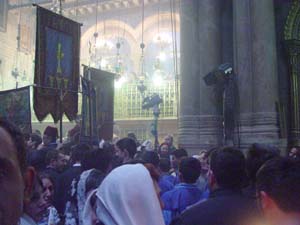 single event, but three separate and simultaneous processions,
all in a single line
circling the Aedicule three times. Click here to
listen to the procession.
single event, but three separate and simultaneous processions,
all in a single line
circling the Aedicule three times. Click here to
listen to the procession.
Each procession pauses from time to time for prayers and readings, obliging the others to do so as well. This triple procession is an old indeed ancient routine, and not quite as disorganised as it might at first appear. At one point the Armenian procession stops in front of the entrance to the Aedicule, to read the Resurrection Gospel and sing the accompanying chants. This concludes with a remarkably moving experience, when we file into the Aedicule, one-by-one to kneel before the cold slab of the tomb and reverence what was intended to be the final resting place of our Lord Jesus.
The procession concludes with a visit to the narthex of the basilica (near the Calvary chapels.) Then it is time for breakfast, and the seminarians prepare a simply meal of fresh Palestinian bread (a kind of elongated bagel), with cheese, falafel, tomatoes, cucumbers and a cup of sweet tea. Afterwards, I join the Bishop of France and Fr. Goossan when they return to the monastery. There we find the Patriarch of Istanbul and Archbishop Nourhan, Grand Sacristan of the monastery, waiting for us in Fr. Goossan's salon where a welcome cup of fresh Armenian coffee is served.
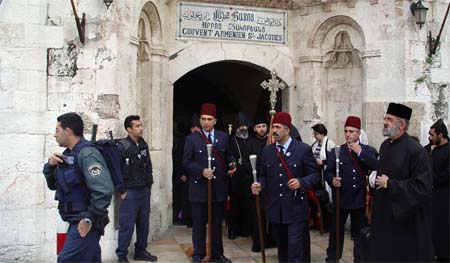
At 6:30 a.m. we gather once again at the main gate of the monastery this time to escort the Patriarch of Istanbul through the narrow walkways of Old Jerusalem, where the shop keepers are opening their stalls at what they hope will be a profitable Easter day. In fact many of the shops nearest the basilica have been open through the night eager to supply the trickle of Easter pilgrims with a great array of Christian memorabilia.
On entering the basilica, the Patriarch and Archbishop Nourhan withdraw to the Armenian sitting room for a few moments, time enough for the Patriarch to go over his sermon while the Grand Sacristan oversees the preparations for the Great Paschal Badarak.
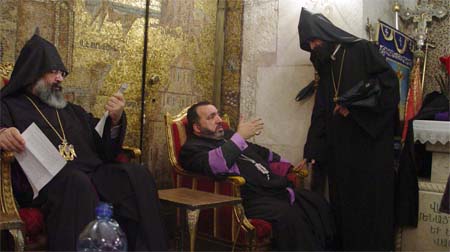
The Armenian community then gathers around the temporary platform in front of the Aedicule for the Sunrise Office (Lauds) at the entrance to the Empty Tomb.
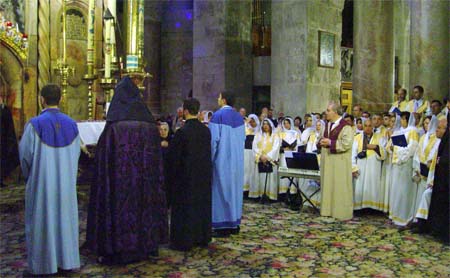
The large mixed voiced choir from Istanbul has taken position to sing for the Divine Liturgy, and the many pilgrims from around the Armenian world have begun arriving for the celebration. Midway through the office, the Patriarch asks for absolution from the Armenian monks, and goes off to vest for the Divine Liturgy.
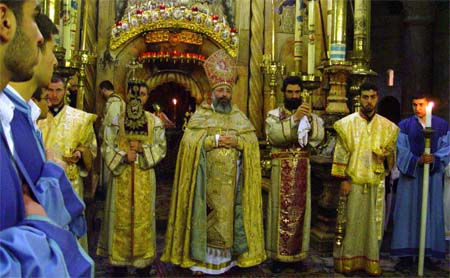
Patriarch Mesrob of Istanbul has really come to Jerusalem to help
relieve some of the burden of liturgical leadership from the aging
Patriarch Torkum of Jerusalem. Mesrob Serpazan is a great bear of a man,
with a deeply caring demeanour. In my few interactions with him I am
impressed by his personal warmth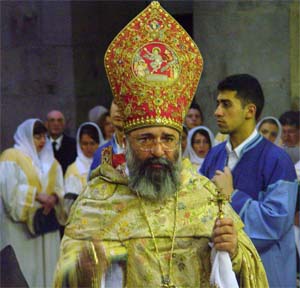 .
Later he will tell me, "You must come and stay with us in Istanbul as
well!" ... would that time allowed! Perhaps another year.
.
Later he will tell me, "You must come and stay with us in Istanbul as
well!" ... would that time allowed! Perhaps another year.
It has been suggested that the Armenian Badarak has much in common with Grand Opera. The Badarak that I have grown to know and admire over the past few months seems ideally suited for the majestic setting of the great rotunda of the Resurrection Basilica and for the most glorious of Christian occasions, the Easter Sunday liturgy.
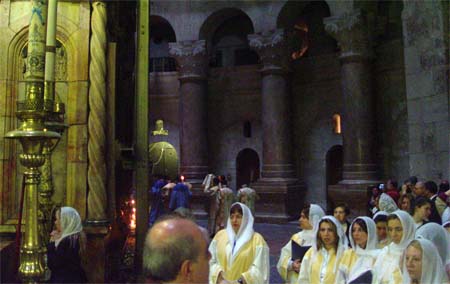
I watch with wonder as the procession of the Great Entrance makes its way around the rear of the Aedicule (above), indeed the grand scale of this worship space is perfectly suited for the grandeur of Orthodox liturgy in general, and especially so for the Armenian Badarak.
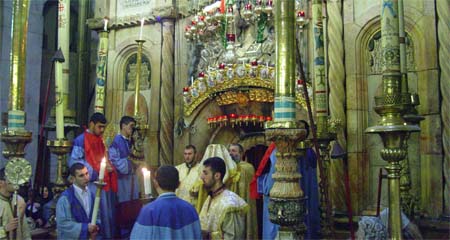
Once he has received the gifts at the conclusion of the Great Entrance, Patriarch Mesrob takes them inside the Aedicule where he will celebrate the Badarak on the altar above the mortuary slab of the Empty Tomb, the traditional site of the actual Resurrection. The Patriarch's great voice is lost within the walls of the Aedicule, but an assisting priest gives signals to the choir marking the movement through the stages of the Anamnesis, or the "remembering", the term used by the Armenians to describe the Eucharistic prayer. Jesus said, "Do this in memory of me."

The choir today is also well matched for the space and the for this glorious occasion. There are perhaps 50 singers or more, all with strong trained voices. They sing the majestic music of Istanbul's own Hayr Gomitas, one of two Badarak settings in general use in the Armenian churches (the other, by Yekmalian.) The Gomitas setting and this great choir from Istanbul is surely a match made in heaven, and the result is sublime.
Click here for short movie of the choir singing "Haménayni orhnyal yés, Dér" which comes shortly after the consecration of the bread and wine, "In all things blessed art thou, O Lord. We bless thee, we praise thee: We give thanks to thee; We pray unto thee, O Lord our God."
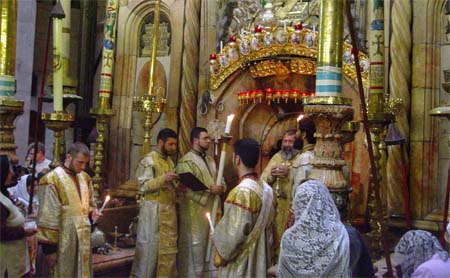
When it comes time for communion, the Patriarch emerges from the Aedicule bearing the elements of bread and wine now transformed into the Body and Blood of the Risen Christ. Easter for the Christian is not a fact of history to be proved or disproved, it is rather a fact of the ultimate reality to be believed or denied, and in the Eucharistic banquet we can actually "taste and see [for ourselves] that the Lord is good" and truly Risen indeed.
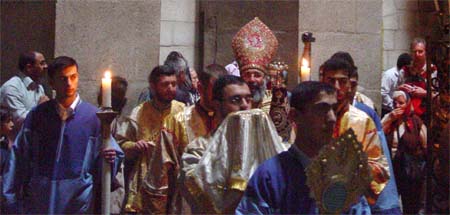
Following the communion, a procession is formed and once again we circle around the Aedicule three times, in the third and final procession of the past twenty-four hours, and the 16th hour spent in church over the same period.
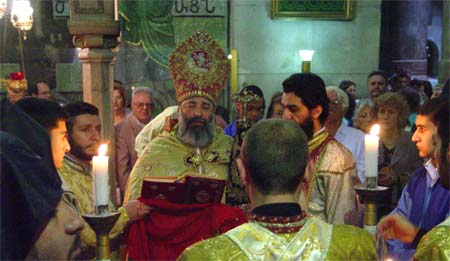
The Badarak concludes with the reading of the Last Gospel in the Armenian sector of the great rotunda.
When the Patriarch goes off to change out
of his Eucharistic vestments, I join some of the seminarians for the
return trip to the Patriarchate. Their English is generally quite good, the former dean of the
Anglican Cathedral of St. George, Jerusalem, is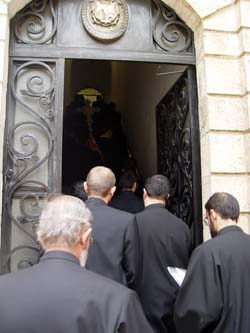 one of their teachers and it shows. The seminarians are the real work
horses of the Armenian liturgies here; and when I ask if they have a
holiday at Easter, one of the seminarians responds, "Of course, this is
it!"
one of their teachers and it shows. The seminarians are the real work
horses of the Armenian liturgies here; and when I ask if they have a
holiday at Easter, one of the seminarians responds, "Of course, this is
it!"
Near Jaffa Gate we pause to wait for Patriarch Mesrob and his entourage so that we can join them for the last stretch of the walk back to the Monastery.
Once we arrive at the Patriarchate, we climb the stairs to meet the Patriarch of Jerusalem in the great hall of his official residence, where he is waiting to greet us (pictured, centre) and to give his Easter Blessing.
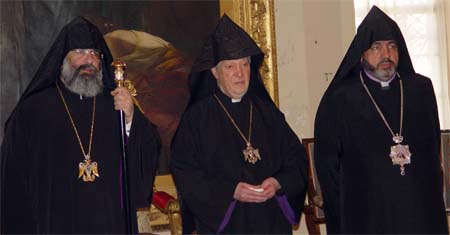
There then follows a break of a couple of hours, long enough to catch up on a bit of sleep before the monastic community joins the Armenian pilgrims for Easter brunch. We have all been invited (more than 200 in all) to a feast organised by the Jerusalem chapter of the Armenian youth and sports club Homenetmen (something like the Armenian YM or YWCA). This organisation is known throughout the international Armenian community, and the festive brunch (mezze, roast lamb and fruit) is served in the large auditorium of their "clubhouse" -- one of the buildings in the courtyard of the monastery
After another couple of hours of rest, it is time for the next event; and we gather in the courtyard for the traditional Andastan (uplifting) service -- the blessing of the four corners of the world, something comparable to Rogation services in the Anglican tradition. The Andastan takes place about a dozen times a year, and this is the fourth time I've seen it.
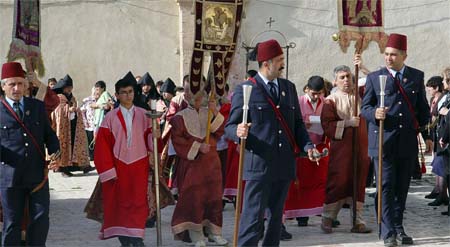
The Easter Sunday Andastan is a hallmark event in the life of the Armenian Quarter, and many pilgrims and tourists have it high on their agenda for this Orthodox Easter Afternoon. The weather is perfect for the outdoor service, and the crimson and gold of the copes and tunics are simply dazzling in the afternoon sun -- talk about a Kodak moment!
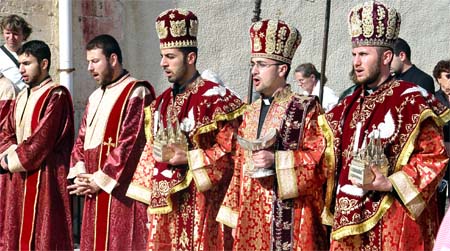
For the blessing of the four corners, the monks, seminarians, and deacons form a large rectangle with Patriarch Torkum of Jerusalem on one side, the deacons opposite and the monks and seminarians completing the rectangle on either side.
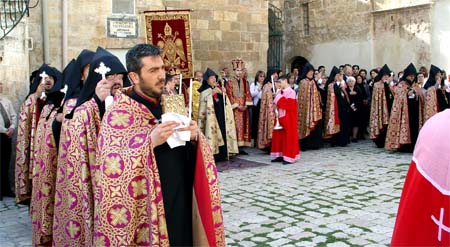
The rectangle then rotates four times so that the Patriarch can pronounce the Andastan blessing to each of the four corners of the earth.
-
Facing East, he prays "for the patriarchate and the republic of the Armenians."
-
Facing West, "for the realms of Christendom."
-
Facing South, "for the lands, the fields, and the fruit yields of the year."
-
Facing North, "for the monasteries, hermitages, cities and villages and the people who dwell in them."

The colourful ceremony lasts a bit more than an hour, and is followed by another short pause in the very full schedule of services and activities for the great feast of Easter.
In the evening we are bussed to one of
Jerusalem's more famous restaurants, the "Christmas Hotel" which I
happen to know fairly well, it is located across the street from St.
George's (Anglican) Cathedral,
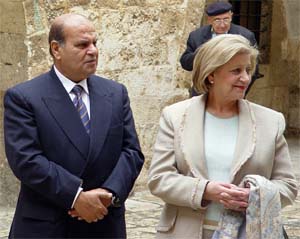 and I have eaten here before. The wife of
the Palestinian Christian owner of the restaurant is Armenian (pictured
here, the next day at the Monastery.)
and I have eaten here before. The wife of
the Palestinian Christian owner of the restaurant is Armenian (pictured
here, the next day at the Monastery.)
The food is excellent (typical Middle Eastern, delicious mezze and a variety of kebabs) and joining us for the banquet are the members of the fabulous mixed choir from Istanbul. The presence of the choir and the fact that Armenians love to sing -- and seem to know a vast number of songs, both ancient and modern -- means it is no surprise when about a half hour into the meal, the assembly fills the restaurant with song after song, and does so continuously for more than three hours!
Soloists take turns dazzling the assembly, and easily the star of the evening is young Fr. Kohren from Armenia, who I learn later is studying voice in Italy. He gives a positively stunning performance of "O sole mio" and participates in something of a duelling tenors routine with the robust lead of the tenor section in the Istanbul choir. Fr. Goossan also delights us with his fine tenor, singing a beautiful lament from the folk repertory.
Nourhan Serpazan has a magnificent bass voice, and both he and Patriarch Mesrob of Istanbul keep the singing going, proposing one tune after another, singing on and on. Patriarch Torkum, well known as a musician and composer himself, takes obvious delight in the singing, and there can be no doubt that this is a wonderful way to complete the celebrations of this Orthodox Easter Sunday in Jerusalem!